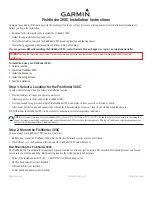
FF520
Page 15
3. FISH FINDER
This chapter is intended to help you understand how STANDARD HORIZON GPS Chart
Plotters with the FF520 connected operate.
The FF520 consists of a high power transmitter, sensitive receiver and a transducer. The
FF520 sends an electrical pulse to the transducer which contains a element that converts
the pulse into acoustic (sound) wave which is sent through the water. As this wave travels
from the transducer to the bottom, it may strike fish, structures, thermal clines (temperature
changes in the water). When the wave strikes an object(s) a certain amount of the wave is
reflected back to the transducer depending on the composition and shape of the object.
When the reflected wave is returned to the transducer it is converted into a voltage and is
amplified by the receiver, processed and sent to the display. The speed of sound in water
is roughly 4800 ft./sec, so the time lapse between the transmitted signal and the received
echo can be measured and the distance to the object determined.
Figure 3 - Fish Finder working principle
3.0
UNDERSTANDING THE FISH FINDER PAGE
The display on STANDARD HORIZON GPS Chart Plotters shows a history of time of the
echoes received by the transducer. The STANDARD HORIZON GPS Chart Plotters have a
menu that allows adjustments to receiver sensitivity, depth range and scrolling speed of the
Fish Finder display.
Summary of Contents for FF520
Page 1: ...FF520 50 200kHz BLACK BOX FISH FINDER Owner s Manual ...
Page 30: ...Page 32 FF520 ...
Page 36: ...Page 38 FF520 ...




































